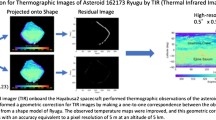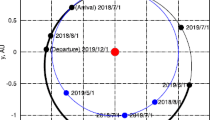Abstract
The thermal infrared imager (TIR) is a thermal infrared camera onboard the Hayabusa2 spacecraft. TIR will perform thermography of a C-type asteroid, 162173 Ryugu (1999 JU3), and estimate its surface physical properties, such as surface thermal emissivity \(\epsilon \), surface roughness, and thermal inertia \(\varGamma \), through remote in-situ observations in 2018 and 2019. In prelaunch tests of TIR, detector calibrations and evaluations, along with imaging demonstrations, were performed. The present paper introduces the experimental results of a prelaunch test conducted using a large-aperture collimator in conjunction with TIR under atmospheric conditions. A blackbody source, controlled at constant temperature, was measured using TIR in order to construct a calibration curve for obtaining temperatures from observed digital data. As a known thermal emissivity target, a sandblasted black almite plate warmed from the back using a flexible heater was measured by TIR in order to evaluate the accuracy of the calibration curve. As an analog target of a C-type asteroid, carbonaceous chondrites (\(50~\mbox{mm} \times 2~\mbox{mm}\) in thickness) were also warmed from the back and measured using TIR in order to clarify the imaging performance of TIR. The calibration curve, which was fitted by a specific model of the Planck function, allowed for conversion to the target temperature within an error of 1 ∘C (\(3\sigma \) standard deviation) for the temperature range of 30 to 100 ∘C. The observed temperature of the black almite plate was consistent with the temperature measured using K-type thermocouples, within the accuracy of temperature conversion using the calibration curve when the temperature variation exhibited a random error of 0.3 ∘C (\(1\sigma \)) for each pixel at a target temperature of 50 ∘C. TIR can resolve the fine surface structure of meteorites, including cracks and pits with the specified field of view of 0.051∘ (\(328 \times 248~\mbox{pixels}\)). There were spatial distributions with a temperature variation of 3 ∘C at the setting temperature of 50 ∘C in the thermal images obtained by TIR. If the spatial distribution of the temperature is caused by the variation of the thermal emissivity, including the effects of the surface roughness, the difference of the thermal emissivity \(\Delta \epsilon \) is estimated to be approximately 0.08, as calculated by the Stefan-Boltzmann raw. Otherwise, if the distribution of temperature is caused by the variation of the thermal inertia, the difference of the thermal inertia \(\Delta \varGamma \) is calculated to be approximately \(150~\mbox{J}\,\mbox{m}^{-2}\,\mbox{s}^{0.5}\,\mbox{K}^{-1}\), based on a simulation using a 20-layer model of the heat balance equation. The imaging performance of TIR based on the results of the meteorite experiments indicates that TIR can resolve the spatial distribution of thermal emissivity and thermal inertia of the asteroid surface within accuracies of \(\Delta \epsilon \cong 0.02\) and \(\Delta \varGamma \cong 20~\mbox{J}\,\mbox{m}^{-2}\,\mbox{s}^{0.5}\,\mbox{K}^{-1}\), respectively. However, the effects of the thermal emissivity and thermal inertia will degenerate in thermal images of TIR. Therefore, TIR will observe the same areas of the asteroid surface numerous times (\({>}10\) times, in order to ensure statistical significance), which allows us to determine both the parameters of the surface thermal emissivity and the thermal inertia by least-squares fitting to a thermal model of Ryugu.









Similar content being viewed by others
References
J.B. Adams, A.L. Filice, Spectral reflectance 0.4 to 2.0 microns of silicate powders. J. Geophys. Res. 72, 5705–5715 (1967)
A.M. Baldridge, S.J. HooK, C.I. Grove, G. Rivera, The ASTER spectral library version 2.0. Remote Sens. Environ. 113, 711–715 (2009)
P.R. Bevington, D.K. Robinson, Data Reduction and Error Analysis for the Physical Sciences, 3rd edn. (McGraw–Hill, New York, 2002)
W.F. Bottke Jr., D. Vokrouhlický, D.P. Rubincam, D. Nesvorný, The Yarkovsky and YORP effects: implications for asteroid dynamics. Annu. Rev. Earth Planet. Sci. 34, 157–191 (2006)
Brucker Optics, http://www.bruker.jp/
S.J. Bus, R.P. Binzel, Phase II of the small main-belt asteroid spectroscopic survey. A feature-based taxonomy. Icarus 158(1), 146–177 (2002)
H. Campins, J.P. Emery, M. Kelley, Y. Fernández, J. Licandro, M. Delbó, A. Barucci, E. Dotto, Spitzer observations of spacecraft target 162173 (1999 JU3). Astron. Astrophys. 503, L17–L20 (2009)
CI Systems, http://www.ci-systems.com/
J. Crank, P. Nicolson, A practical method for numerical evaluation of solutions of partial differential equations of the heat-conduction type. Proc. Camb. Philol. Soc. 43, 50–67 (1947)
M. Delbo, M. Mueller, J.P. Emery, B. Rozitis, M.T. Capria, Asteroid thermophysical modeling, in Asteroids IV, ed. by P. Michel et al.(University of Arizona Press, Tucson, 2015), pp. 107–128
T. Fukuhara, M. Taguchi, T. Imamura, M. Nakamura, M. Ueno, M. Suzuki, N. Iwagami, M. Sato, K. Mitsuyama, G.L. Hashimoto, R. Ohshima, T. Kouyama, H. Ando, M. Futaguchi, LIR: longwave infrared camera onboard the Venus orbiter Akatsuki. Earth Planets Space 63, 1009–1018 (2011)
S. Hasegawa, T.G. Müller, K. Kawakami, T. Kasuga, T. Wada, Y. Ita, N. Takato, H. Terada, T. Fujiyoshi, M. Abe, Albedo, size, and surface characteristics of Hayabusa-2 sample-return target 162173 1999 JU3 from AKARI and Subaru observations. Publ. Astron. Soc. Jpn. 60, 399–405 (2008)
B.R. Hawke, D.T. Blewett, P.G. Lucey, G.A. Smith, J.F. Bell III, B.A. Campbell, M.S. Robinson, The origin of lunar crater rays. Icarus 170, 1–16 (2004)
T. Iwata, K. Kitazato, M. Abe, M. Ohtake, T. Arai, T. Arai, N. Hirata, T. Hiroi, C. Honda, N. Imae, M. Komatsu, T. Matsunaga, M. Matsuoka, S. Matsuura, T. Nakamura, A. Nakato, Y. Nakauchi, T. Osawa, H. Senshu, Y. Takagi, K. Tsumura, N. Takato, S. Watanabe, M.A. Barucci, E. Palomba, M. Ozaki, NIRS3: the near infrared spectrometer on Hayabusa2. Space Sci. Rev. (2017). doi:10.1007/s11214-017-0341-0
S. Kameda, H. Suzuki, Y. Cho, S. Koga, M. Yamada, T. Nakamura, T. Hiroi, H. Sawada, R. Honda, T. Morota, C. Honda, A. Takei, T. Takamatsu, Y. Okumura, M. Sato, T. Yasuda, K. Shibasaki, S. Ikezawa, S. Sugita, Detectability of hydrous minerals using ONC-T camera onboard the Hayabusa2 spacecraft. Adv. Space Res. 56(7), 1519–1524 (2015). doi:10.1016/j.asr.2015.06.037
D. Lazzaro, M.A. Barucci, D. Perna, F.L. Jasmim, M. Yoshikawa, J.M.F. Carvano, Rotational spectra of (162173) 1999 JU3, the target of the Hayabusa2 mission. Astron. Astrophys. 549, L2 (2013)
M. Müller, Surface properties of asteroids from mid-infrared observations and thermophysical modeling. PhD dissertation, Freie Universitaet, Berlin (2007)
T.G. Müller, J. D̂urech, S. Hasegawa, M. Abe, K. Kawakami, T. Kasuga, D. Kinoshita, D. Kuroda, S. Urakawa, S. Okumura, Y. Sarugaku, S. Miyasaka, Y. Takagi, P.R. Weissman, Y.-J. Choi, S. Larson, K. Yanagisawa, S. Nagayama, Thermo-physical properties of 162173 (1999 JU3), a potential flyby and rendezvous target for interplanetary missions. Astron. Astrophys. 525, A145 (2011)
T. Nakamura, T. Iwata, K. Kitasato, M. Abe, T. Osawa, M. Matsuoka, Y. Nakauchi, T. Arai, M. Komatsu, T. Hiroi, N. Imae, A. Yamaguchi, H. Kojima, Reflectance spectra measurement of various carbonaceous chondrites using Hayabusa-2 near infrared spectrometer. 78th Annual Meeting of the Meteoritical Society, abstract#5206 (2015)
Nippon Avionics, http://www.avio.co.jp/english/
T. Okada, T. Fukuhara, S. Tanaka, M. Taguchi, T. Imamura, T. Arai, H. Senshu, Y. Ogawa, H. Demura, K. Kitazato, R. Nakamura, T. Kouyama, T. Sekiguchi, S. Hasegawa, T. Matsunaga, T. Wada, J. Takita, N. Sakatani, Y. Horikawa, K. Endo, J. Helbert, T.G. Müller, A. Hagermann, Hayabusa2 TIR team, thermal infrared imaging experiments of C-type asteroid 162173 Ryugu on Hayabusa2. Space Sci. Rev. (2016). doi:10.1007/s11214-016-0286-8
C.P. Opeil, G.J. Consolmagno, D.T. Britt, The thermal conductivity of meteorites: new measurements and analysis. Icarus 208(1), 449–454 (2010)
W.H. Press, S.A. Teukolsky, W.T. Vetterling, B.P. Flannery, Modeling of Data, Numerical Recipes, 3rd edn. (Cambridge University Press, Cambridge, 2007a), pp. 773–839. Chap. 15
W.H. Press, S.A. Teukolsky, W.T. Vetterling, B.P. Flannery, Interpolation and Extrapolation, Numerical Recipes, 3rd edn. (Cambridge University Press, Cambridge, 2007b), pp. 110–154. Chap. 3
W.H. Press, S.A. Teukolsky, W.T. Vetterling, B.P. Flannery, Partial Differential Equations, Numerical Recipes, 3rd edn. (Cambridge University Press, Cambridge, 2007c), pp. 1024–1096. Chap. 20
B. Rozitis, S.F. Green, Directional characteristics of thermal-infrared beaming from atmosphereless planetary surfaces—a new thermophysical model. Mon. Not. R. Astron. Soc. 415, 2042–2062 (2011)
N. Sakatani, K. Ogawa, Y. Iijima, R. Honda, S. Tanaka, Experimental study for thermal conductivity structure of lunar surface regolith: effect of compressional stress. Icarus 221(2), 1180–1182 (2012)
J.R. Spencer, L.A. Lebovsky, M.A. Sykes, Systematic biases in radiometric diameter determinations. Icarus 78, 337–354 (1989)
J. Takita, H. Senshu, S. Tanaka, Feasibility and accuracy of thermophysical estimation of asteroid 162173 Ryugu (1999 JU3) from the Hayabusa2 thermal infrared imager. Space Sci. Rev. (2017). doi:10.1007/s11214-017-0336-x
Y. Tsuda, M. Yoshikawa, M. Abe, H. Minamino, S. Nakazawa, System design of the Hayabusa 2—asteroid sample return mission to 1999 JU3. Acta Astronaut. 91, 356–362 (2013)
W.R. Van Schmus, J.A. Wood, A chemical-petrologic classification for the chondritic meteorites. Geochim. Cosmochim. Acta 31(5), 747 (1967)
F. Vilas, Spectral characteristics of Hayabusa 2 near-Earth asteroid targets 162173 1999 JU3 and 2001 QC34. Astron. J. 135, 1101–1105 (2008)
M.K. Weisberg, T.J. McCoy, A.N. Krot, Systematics and evaluation of meteorite classification, in Meteorites and the Early Solar System II, ed. by D.S. Lauretta, H.Y. McSween (University of Arizona Press, Tucson, 2006)
K. Yomogida, T. Matsui, Physical properties of ordinary chondrites. J. Geophys. Res. 88, 9513–9533 (1983)
Acknowledgements
We thank T. Matsunaga, M. Matsuoka, and S. Matsuura for their comments and supports of the prelaunch experiments. We are grateful to all members of the Hayabusa2 team and thank NEC Inc. Co. who made the flight model of TIR.
Author information
Authors and Affiliations
Corresponding author
Appendix: Heat Balance Model for Meteorite Experiments
Appendix: Heat Balance Model for Meteorite Experiments
The thermal inertia of the meteorites is approximately derived using a heat balance model. The heat flow in the meteorite layer is simply modeled using a one-dimensional, non-steady-state heat transfer equation, as follows:
where \(\kappa \) is the thermal conductivity (W m−1 K−1), \(c_{p}\) is the specific heat (J kg−1 K−1), and \(\rho \) is the density (kg m−3). The initial temperature is set to room temperature, and the boundary condition is obtained based on the heat balance of the Fourier equation, the Stefan-Boltzmann raw, i.e., Eq. (2), and the convective heat for the surroundings, as shown in Fig. 10. The boundary condition is written as follows:
where \(q(x_{0}, t)\) is the heat flux supplied from the heater to the back side of the meteorite (W m−2), \(T(\infty , t)\) is the surrounding temperature (K), and \(H\) is the convective heat transfer coefficient (W m−2 K−1). The heated layer is set as the back side of the meteorite (\(x=x_{0}\)), and the imaging layer of TIR is the front side of the meteorite (\(x=x_{N}\)). Indexes 0 through \(N\) indicate the layer number. A 20-layer model is used in this calculation. The convective heat is dominant under these conditions (atmospheric conditions). The spatial variation of thermal emissivity is assumed to be negligible, and the value of thermal emissivity \(\epsilon \) is assumed to be constant at 0.98.
Schematic diagram of the one-dimensional heat balance model of the warmed meteorite. The meteorites were warmed from the back side of the specimen using a heater. The heat balance boundaries were the meteorite surface (\(x=x_{N}\)) and the heated layer (\(x=x_{0}\)). The temperatures at these boundaries were measured using type K thermocouples. In the present study, a non-steady heat balance equation was approximately solved for 20 layers using a numerical finite difference method (implicit method)
The heat balance equation can be approximately solved using a numerical finite difference method (implicit method) (Crank and Nicolson 1947; Press et al. 2007c). The variance of this finite difference equation becomes a quartic equation of temperature \(T(x_{N})\). This quartic equation can be solved using a classical quartic formula of the Ferrari method (Cardano’s formula). Equations (7) and (8) are fitted to the measured temperature with the thermocouple data by least-squares fitting. The free parameters for the fit are \(\kappa \) and \(H\), and the values of \(\rho \) and \(c_{p}\) are assumed to be constant.
Rights and permissions
About this article
Cite this article
Arai, T., Nakamura, T., Tanaka, S. et al. Thermal Imaging Performance of TIR Onboard the Hayabusa2 Spacecraft. Space Sci Rev 208, 239–254 (2017). https://doi.org/10.1007/s11214-017-0353-9
Received:
Accepted:
Published:
Issue Date:
DOI: https://doi.org/10.1007/s11214-017-0353-9





